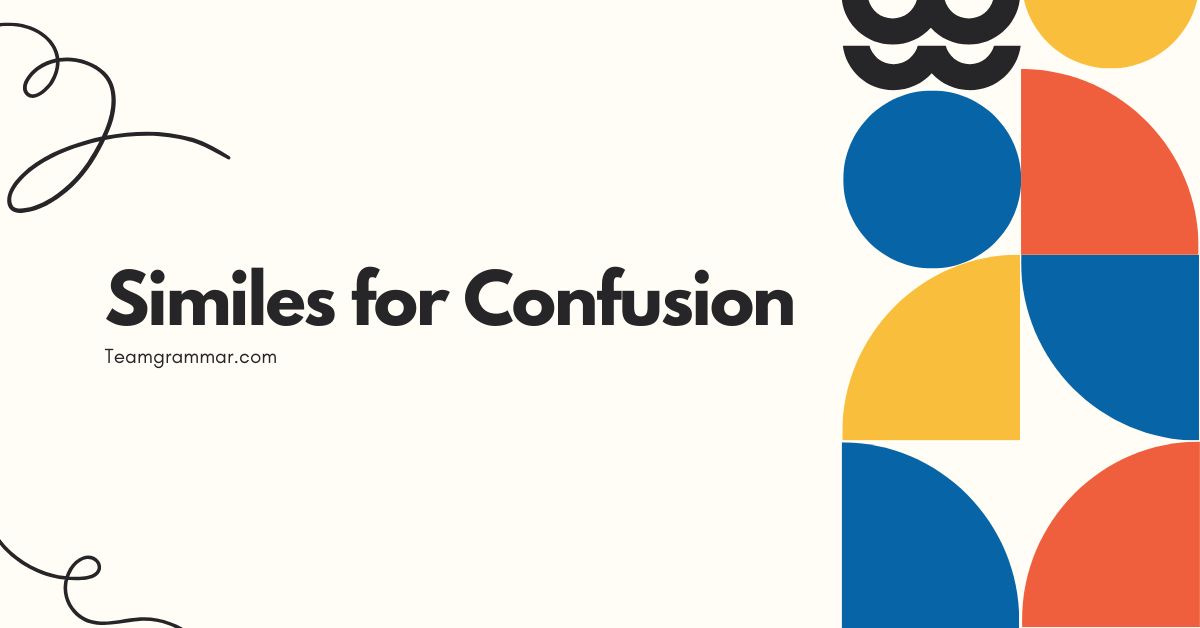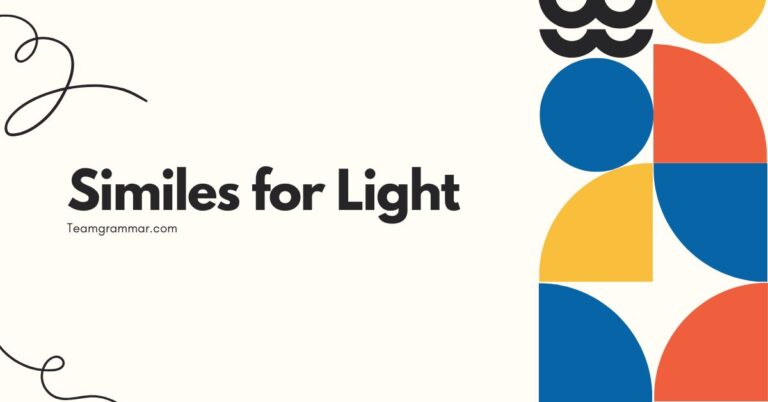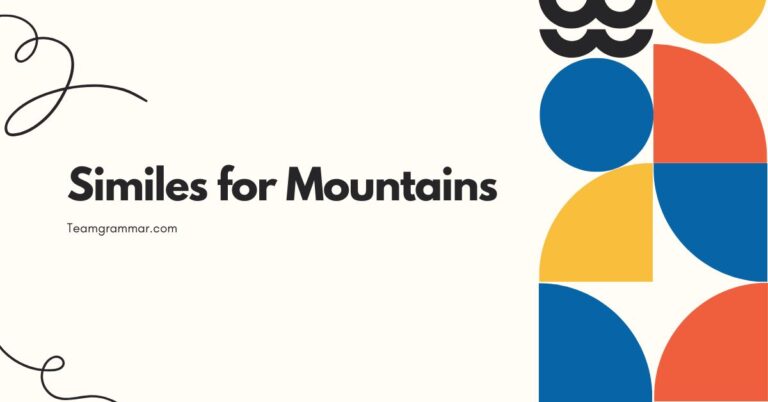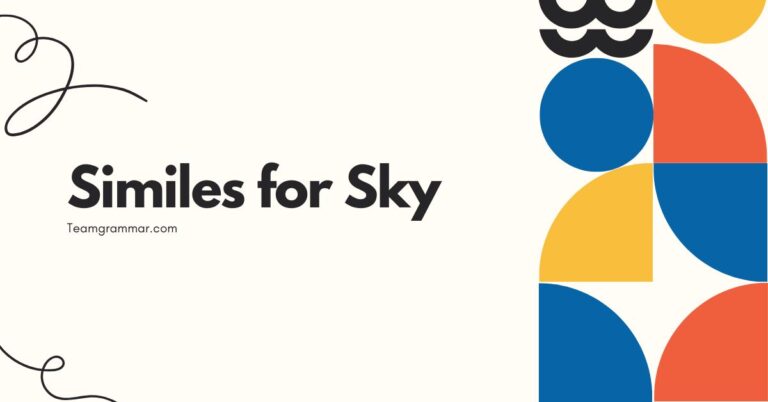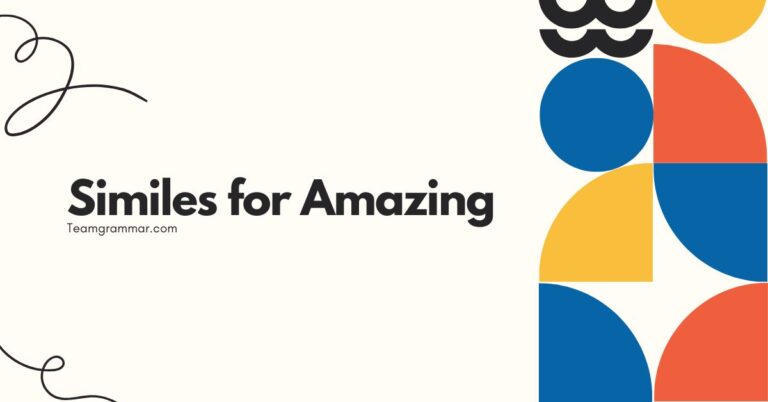28 Similes for Confusion: A Comprehensive Guide
Understanding how to effectively use similes to describe confusion is crucial for vivid and engaging writing. Similes allow us to paint a picture of bewilderment, uncertainty, and disorientation in a way that resonates with readers.
This guide explores the definition, structure, and types of similes related to confusion, providing numerous examples and practical exercises. Whether you’re a student, writer, or English language learner, this article will equip you with the tools to master the art of using similes to express confusion.
By delving into the nuances of similes, you’ll learn how to create more descriptive and impactful sentences. This not only enhances your writing skills but also improves your comprehension of literature and everyday conversations.
This article is designed for anyone who wants to enrich their vocabulary and gain a deeper understanding of figurative language. Let’s unravel the complexities of similes for confusion and elevate your communication skills.
Table of Contents
- Definition of Similes for Confusion
- Structural Breakdown of Similes for Confusion
- Types and Categories of Similes for Confusion
- Examples of Similes for Confusion
- Usage Rules for Similes for Confusion
- Common Mistakes When Using Similes for Confusion
- Practice Exercises
- Advanced Topics
- Frequently Asked Questions
- Conclusion
Definition of Similes for Confusion
A simile is a figure of speech that directly compares two different things, using the words “like” or “as.” It’s a powerful tool for creating vivid imagery and conveying complex emotions or ideas in a relatable way. In the context of confusion, similes help us articulate the feeling of being perplexed, disoriented, or uncertain by drawing parallels to other easily understandable concepts or experiences.
Similes differ from metaphors, which imply a direct equivalence between two things (e.g., “He is a lion”). Similes, on the other hand, acknowledge the difference while highlighting a similarity (e.g., “He islikea lion”).
This distinction is crucial in understanding the nuanced ways in which similes function to express confusion. The use of “like” or “as” creates a softer, more suggestive comparison, allowing for a more subtle and evocative description of bewilderment.
The function of similes for confusion is to provide a concrete and relatable image that captures the abstract feeling of being confused. By comparing confusion to something tangible, such as a maze or a fog, we can better understand and communicate the experience.
This makes similes an invaluable tool for writers, speakers, and anyone who wants to express their thoughts and feelings with greater clarity and impact.
Structural Breakdown of Similes for Confusion
Similes follow a basic structural pattern: **A is like B** or **A is as [adjective] as B**. In the context of confusion, “A” represents the state of confusion, and “B” represents something that is analogous to that state.
Understanding this structure is essential for creating effective and meaningful similes.
The key components of a simile for confusion are:
- The Subject (A): The person, object, or situation experiencing confusion.
- The Linking Word (like or as): The word that establishes the comparison.
- The Analogy (B): The thing to which the subject is being compared. This is what provides the context for understanding the confusion.
For example, in the simile “His mind was like a tangled web,” “His mind” is the subject, “like” is the linking word, and “a tangled web” is the analogy. The analogy of a tangled web helps us visualize and understand the state of confusion the subject is experiencing.
The adjective in the “as…as” structure further refines the comparison, highlighting a specific quality that the subject and analogy share. For example, “He was as lost as a ship without a compass” emphasizes the feeling of being directionless, a key aspect of confusion.
Types and Categories of Similes for Confusion
Similes for confusion can be categorized based on the type of analogy they use. Here are some common categories:
Similes Based on Spatial Disorientation
These similes compare confusion to physical environments or situations that involve a loss of direction or bearings. They evoke a sense of being lost or trapped.
Similes Based on Mental Disarray
These similes compare confusion to states of mental disorder or chaos, such as a jumbled mess or a broken machine. They emphasize the feeling of mental disorganization.
Similes Based on Sensory Overload
These similes compare confusion to situations where the senses are overwhelmed, such as a loud noise or a blinding light. They highlight the feeling of being overwhelmed and unable to process information.
Similes Based on Unclear Visibility
These similes compare confusion to situations where vision is obscured, such as a fog or a mist. They emphasize the lack of clarity and the inability to see things clearly.
Similes Based on Mechanical Failure
These similes compare confusion to the breakdown or malfunction of a machine or system. They highlight the sense of something not working as it should.
Examples of Similes for Confusion
Below are several tables containing examples of similes for confusion, categorized by the types mentioned above. Each example is designed to illustrate how different analogies can be used to effectively convey the feeling of confusion.
Examples of Similes Based on Spatial Disorientation
These examples illustrate how confusion can feel like being lost in a physical space.
| Simile | Explanation |
|---|---|
| He felt like he was wandering in a maze. | Implies a complex and disorienting situation. |
| She was as lost as a ship without a radar. | Highlights a lack of direction and guidance. |
| His thoughts were like a winding, endless road. | Suggests a journey with no clear destination. |
| The instructions were like a map to nowhere. | Indicates that the instructions are unhelpful and misleading. |
| The city felt like a labyrinth to her. | Emphasizes the overwhelming and confusing nature of the city. |
| He was as disoriented as someone in a foreign land. | Highlights the feeling of being unfamiliar with one’s surroundings. |
| Her mind felt like a room with no doors. | Suggests a feeling of being trapped and unable to escape. |
| The situation was like being stuck in quicksand. | Implies a sense of being trapped and sinking further into confusion. |
| He felt like he was navigating through a fog. | Highlights the lack of clarity and difficulty in seeing the way forward. |
| The problem was like a never-ending tunnel. | Suggests a long and difficult journey with no clear end in sight. |
| She felt like she was walking in circles. | Implies a repetitive and unproductive effort. |
| His understanding of the topic was like a house with no foundation. | Suggests a lack of solid understanding or knowledge. |
| The explanation was as clear as mud. | Indicates that the explanation is completely incomprehensible. |
| He felt like he was lost in a thick forest. | Emphasizes the feeling of being surrounded by confusion and uncertainty. |
| She was as adrift as a boat without a sail. | Highlights the lack of control and direction. |
| The project felt like climbing an endless staircase. | Suggests a long and arduous task with no clear end. |
| He was as bewildered as a tourist in a crowded market. | Highlights the overwhelming and confusing nature of the environment. |
| The directions were like a riddle wrapped in an enigma. | Indicates that the directions are complex and difficult to understand. |
| She felt like she was trapped in a hall of mirrors. | Implies a distorted and confusing perception of reality. |
| His thoughts were like a tangled ball of yarn. | Suggests a disorganized and confusing mental state. |
| The task was like trying to find a needle in a haystack. | Emphasizes the difficulty and improbability of success. |
| He felt as though he was navigating a minefield. | Highlights the potential dangers and uncertainties of the situation. |
| The instructions were like a foreign language to him. | Implies a complete lack of understanding. |
| She felt like she was wandering through a desert. | Suggests a barren and unproductive mental landscape. |
| His understanding of the situation was like a broken compass. | Highlights the lack of accurate guidance or direction. |
Examples of Similes Based on Mental Disarray
These examples illustrate how confusion can feel like a state of mental chaos.
| Simile | Explanation |
|---|---|
| Her thoughts were like a jumbled mess. | Implies a disorganized and chaotic mental state. |
| His mind was like a broken record. | Suggests repetitive and unproductive thinking. |
| The information was like a scattered puzzle. | Highlights the difficulty in making sense of the information. |
| His brain felt like scrambled eggs. | Emphasizes the feeling of mental disarray and confusion. |
| She was as confused as a chameleon in a bag of Skittles. | Highlights the overwhelming and chaotic nature of the situation. |
| His memory felt like a shattered mirror. | Suggests fragmented and distorted recollections. |
| Her thoughts were like a tangled fishing line. | Implies a complex and difficult-to-unravel mental state. |
| His understanding was like a cracked vase. | Highlights the fragility and incompleteness of his comprehension. |
| The situation felt like a whirlwind in his mind. | Emphasizes the chaotic and overwhelming nature of the experience. |
| Her brain was like a computer with a virus. | Suggests a malfunction or impairment in her mental processes. |
| His mind felt like a room full of buzzing bees. | Implies a chaotic and distracting mental environment. |
| Her thoughts were as disorganized as a drawer full of mismatched socks. | Highlights the lack of order and coherence in her thinking. |
| His understanding of the problem was like a house of cards. | Suggests a fragile and unstable grasp of the situation. |
| The situation felt like a carnival funhouse. | Emphasizes the distorted and disorienting nature of the experience. |
| Her thoughts were like static on a radio. | Implies a lack of clarity and coherence in her thinking. |
| His mind was like a jukebox playing random songs. | Suggests a chaotic and unpredictable stream of thoughts. |
| Her understanding was as fragmented as a broken mosaic. | Highlights the incomplete and disjointed nature of her comprehension. |
| The situation felt like a circus without a ringmaster. | Emphasizes the lack of control and organization in the experience. |
| His thoughts were like a kaleidoscope of colors. | Implies a complex and ever-changing mental landscape. |
| Her brain was like a beehive of activity. | Suggests a busy and overwhelming mental environment. |
| His understanding was as clear as a foggy mirror. | Highlights the lack of clarity and precision in his comprehension. |
| The situation felt like a broken zipper. | Emphasizes the sense of something being stuck or not working properly. |
| Her thoughts were like a whirlwind of paper scraps. | Implies a chaotic and disorganized mental state. |
| His mind was like a maze of mirrors. | Suggests a distorted and confusing perception of reality. |
| Her understanding was as solid as quicksand. | Highlights the lack of stability and reliability in her comprehension. |
Examples of Similes Based on Unclear Visibility
These examples illustrate how confusion can feel like a lack of visual clarity.
| Simile | Explanation |
|---|---|
| The instructions were as clear as mud. | Indicates that the instructions are completely incomprehensible. |
| His understanding was like looking through a fogged-up window. | Highlights the lack of clarity and difficulty in seeing things clearly. |
| The situation was as transparent as lead. | Implies that the situation is opaque and difficult to understand. |
| He felt like he was trying to see through a brick wall. | Emphasizes the feeling of being unable to penetrate the confusion. |
| Her thoughts were as clear as pea soup. | Indicates that her thoughts are murky and difficult to understand. |
| His explanation was like trying to read in the dark. | Highlights the difficulty in understanding the explanation. |
| The problem was as visible as a ghost. | Implies that the problem is elusive and difficult to detect. |
| He felt like he was navigating through a dense fog. | Emphasizes the lack of clarity and difficulty in seeing the way forward. |
| Her understanding was like looking through a kaleidoscope. | Highlights the distorted and confusing nature of her perception. |
| His thoughts were as clear as a snow globe in a blizzard. | Indicates that his thoughts are chaotic and difficult to follow. |
| The situation was as transparent as a brick wall. | Implies that the situation is opaque and difficult to understand. |
| He felt like he was trying to catch smoke with his hands. | Emphasizes the feeling of being unable to grasp the situation. |
| Her thoughts were as clear as a dirty windshield. | Indicates that her thoughts are obscured and difficult to understand. |
| His explanation was like trying to see through a keyhole. | Highlights the limited and incomplete nature of the information. |
| The problem was as visible as a needle in a haystack. | Implies that the problem is difficult to find or identify. |
| He felt like he was navigating through a maze in the dark. | Emphasizes the lack of clarity and difficulty in finding his way. |
| Her understanding was like looking through a cracked lens. | Highlights the distorted and imperfect nature of her perception. |
| His thoughts were as clear as a muddy stream. | Indicates that his thoughts are murky and difficult to follow. |
| The situation was as transparent as a locked box. | Implies that the situation is hidden and difficult to access. |
| He felt like he was trying to grasp a shadow. | Emphasizes the feeling of being unable to hold onto the situation. |
| Her thoughts were as clear as a sandstorm. | Indicates that her thoughts are chaotic and difficult to understand. |
| His explanation was like trying to read hieroglyphics. | Highlights the difficulty in deciphering the explanation. |
| The problem was as visible as a drop of water in the ocean. | Implies that the problem is insignificant and difficult to notice. |
Usage Rules for Similes for Confusion
When using similes to describe confusion, keep the following rules in mind:
- Clarity: Ensure that the analogy you’re using is clear and easily understandable. The purpose of a simile is to clarify, not to further confuse.
- Relevance: The analogy should be relevant to the context of the confusion. It should highlight a specific aspect of the confusion that you want to emphasize.
- Originality: While common similes can be effective, strive to create original and imaginative comparisons that will resonate with your audience.
- Consistency: Maintain consistency in your use of similes throughout your writing. Avoid mixing metaphors or similes in a way that creates confusion.
- Appropriateness: Consider the tone and style of your writing when choosing a simile. A simile that is appropriate in one context may not be appropriate in another.
Exceptions to these rules may occur in creative writing, where unconventional or surreal similes can be used to create a specific effect. However, in most cases, it’s best to adhere to these guidelines to ensure that your similes are effective and meaningful.
Common Mistakes When Using Similes for Confusion
Here are some common mistakes to avoid when using similes for confusion:
| Mistake | Incorrect Example | Correct Example |
|---|---|---|
| Using a confusing analogy | His mind was like a quantum entanglement. | His mind was like a tangled web. |
| Using a cliché | He was as confused as a baby. | He was as confused as a tourist in a crowded market. |
| Mixing metaphors and similes | His confusion was a tangled web, a sea of uncertainty. | His confusion was like a tangled web. |
| Using an irrelevant analogy | His mind was like a sunny day. | His mind was like a room with no doors. |
The key to avoiding these mistakes is to carefully consider the analogy you’re using and ensure that it is clear, relevant, and original. It’s also important to maintain consistency in your use of similes and avoid mixing them with metaphors.
Practice Exercises
Test your understanding of similes for confusion with these exercises.
Exercise 1: Identifying Similes
Identify the similes in the following sentences.
| Question | Answer |
|---|---|
| 1. His explanation was as clear as mud. | as clear as mud |
| 2. Her thoughts were like a jumbled mess. | like a jumbled mess |
| 3. He felt like he was wandering in a maze. | like he was wandering in a maze |
| 4. The instructions were like a map to nowhere. | like a map to nowhere |
| 5. She was as lost as a ship without a compass. | as lost as a ship without a compass |
| 6. His brain felt like scrambled eggs. | like scrambled eggs |
| 7. The situation was like being stuck in quicksand. | like being stuck in quicksand |
| 8. Her understanding was like looking through a fogged-up window. | like looking through a fogged-up window |
| 9. His mind was like a broken record. | like a broken record |
| 10. She felt like she was walking in circles. | like she was walking in circles |
Exercise 2: Completing Similes
Complete the following similes with an appropriate analogy.
| Question | Answer |
|---|---|
| 1. His confusion was like _____. | a dense fog |
| 2. She felt as lost as _____. | a tourist in a foreign city |
| 3. The instructions were as clear as _____. | pea soup |
| 4. His mind was like _____. | a room full of echoes |
| 5. She felt like she was trapped in _____. | a maze of mirrors |
| 6. The explanation was like _____. | trying to read in the dark |
| 7. His thoughts were as disorganized as _____. | a drawer full of mismatched socks |
| 8. She felt like she was navigating _____. | a minefield |
| 9. The problem was like _____. | trying to find a needle in a haystack |
| 10. His understanding was as fragile as _____. | a house of cards |
Exercise 3: Writing Similes
Write your own similes to describe the following situations of confusion.
- Trying to understand a complex math problem.
- Being lost in a large city.
- Listening to someone speak in a language you don’t understand.
- Reading a poorly written instruction manual.
- Trying to assemble a piece of furniture without instructions.
Advanced Topics
For advanced learners, consider exploring the use of extended similes and the interplay between similes and other figures of speech, such as metaphors and personification. Extended similes develop a comparison over several sentences or paragraphs, creating a more detailed and nuanced image.
Understanding how these figures of speech interact can enhance your writing and communication skills.
Another advanced topic is the cultural context of similes. Different cultures may have different analogies that are commonly used to express confusion.
Being aware of these cultural differences can help you communicate more effectively with people from different backgrounds.
Frequently Asked Questions
- What is the difference between a simile and a metaphor?
A simile uses “like” or “as” to compare two things, while a metaphor directly equates them. For example, “He is like a lion” (simile) vs. “He is a lion” (metaphor).
- Can a simile be too long?
Yes, a simile can be too long if it becomes overly detailed or distracts from the main point. Keep your similes concise and relevant.
- How can I make my similes more original?
Think outside the box and avoid clichés. Consider using unexpected or unusual analogies that will surprise and engage your audience.
- Is it okay to use multiple similes in a single sentence?
While it’s possible, it’s generally best to avoid using too many similes in a single sentence, as it can become overwhelming and confusing. Focus on using one or two effective similes.
- How do I know if a simile is appropriate for my audience?
Consider the age, background, and knowledge level of your audience. Choose analogies that will be familiar and relatable to them.
- What if I can’t think of a good analogy?
Try brainstorming different ideas and concepts that are related to the feeling or situation you’re trying to describe. Don’t be afraid to experiment and try different things.
- Can similes be used in formal writing?
Yes, similes can be used in formal writing, but it’s important to use them sparingly and choose analogies that are appropriate for the tone and style of the writing.
- Are there any words besides “like” and “as” that can be used to create similes?
While “like” and “as” are the most common words used to create similes, other words such as “than,” “resembles,” and “similar to” can also be used in certain contexts.
- How can I improve my ability to create effective similes?
Practice writing similes regularly and pay attention to the similes used by other writers. Read widely and expose yourself to different styles of writing.
- What role do similes play in creative writing?
Similes add depth, imagery, and emotional resonance to creative writing. They help readers connect with the text on a deeper level and create a more immersive experience.
Conclusion
Mastering the art of using similes to describe confusion can significantly enhance your writing and communication skills. By understanding the definition, structure, and types of similes, you can create vivid and memorable descriptions that resonate with your audience.
Remember to choose clear, relevant, and original analogies, and avoid common mistakes such as using clichés or mixing metaphors.
Practice writing similes regularly and pay attention to the similes used by other writers. With time and effort, you’ll develop a keen eye for identifying effective analogies and crafting similes that capture the essence of confusion.
Embrace the power of similes to elevate your writing and express your thoughts and feelings with greater clarity and impact. Remember, the key to success is consistent practice and a willingness to experiment with different ideas.

